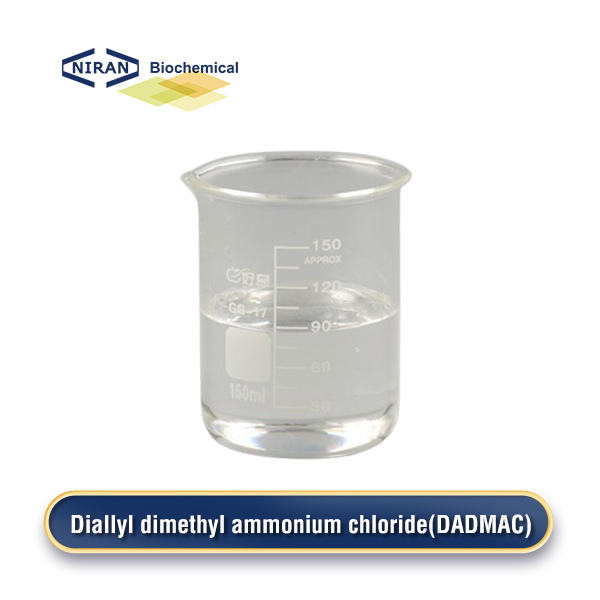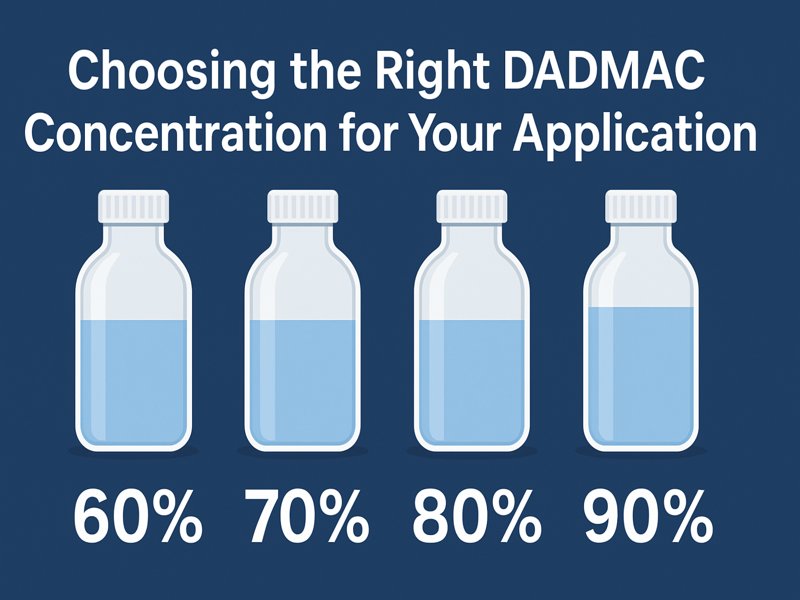DADMAC is a cationic monomer widely used in water treatment, papermaking, textiles, and personal care for its reactivity and solubility. Available in 60–90% aqueous solutions, selecting the right concentration ensures performance, cost-efficiency, and compliance.

Understanding DADMAC: Chemical Overview
Diallyl dimethyl ammonium chloride(DADMAC), with the chemical formula C8H16ClN, is a colorless to pale yellow liquid with high cationic charge density. It polymerizes readily and forms homopolymers or copolymers (e.g., with acrylamide), which are key to flocculation, retention, antistatic, and conditioning functions. The typical properties of DADMAC solutions vary based on concentration:
| Concentration | Viscosity (mPa·s @25°C) | Density (g/cm³) | pH (20°C, 10% solution) | Appearance |
| 60% | ~10–50 | ~1.05–1.07 | 5.0–7.0 | Colorless liquid |
| 70% | ~100–250 | ~1.08–1.10 | 5.0–7.0 | Clear liquid |
| 80% | ~300–600 | ~1.12–1.14 | 5.0–7.0 | Thick liquid |
| 90% | ~800–1200 | ~1.16–1.18 | 5.0–7.0 | Viscous syrup |
As concentration increases, so do viscosity and reactivity, affecting how DADMAC behaves in different systems.
60% Concentration DADMAC
Key Features
- Low viscosity for easy handling and dosing
- Suitable for continuous feed applications
- Economical for low-reactivity needs
Typical Applications
- Water Treatment: Used in municipal and industrial wastewater flocculation, especially where low polymerization rates are acceptable.
- Textile Finishing: Offers basic antistatic and softening properties in diluted formulations.
- Cosmetics: Ideal for leave-on hair and skin care products where a mild cationic charge is needed.
Pros | Cons |
|
|
Ideal Users:
- Water treatment plants with automated dosing
- Cosmetic formulators aiming for gentle cationic activity
- Low-volume or small-batch manufacturers
70% Concentration DADMAC
Key Features
- Balanced performance and stability
- Moderate viscosity, manageable with standard equipment
- Widely available and cost-effective
Typical Applications
- Paper Industry: Commonly used in wet-end additives and retention aids.
- Wastewater Treatment: Effective in oil-water separation and sludge dewatering.
- Hair Care Products: Provides detangling, conditioning, and film-forming effects.
Pros | Cons |
|
|
Ideal Users
- Paper mills are looking for strong retention without high reactivity
- Personal care manufacturers need consistent quality and pricing
- Mid-size chemical companies producing water treatment agents
80% Concentration DADMAC
Key Features
- High reactivity and concentration
- More efficient monomer for polymerization
- Increased ionic strength per unit volume
Typical Applications
- Flocculant Manufacturing: Used as a monomer for producing high-molecular-weight cationic polymers.
- Antistatic Agents: Provide stronger binding to fiber surfaces in textiles.
- Water Recycling Systems: Effective in removing suspended solids and organics.
Pros | Cons |
|
|
Ideal Users
- Polymer producers focusing on performance-grade water treatment chemicals
- Textile processors dealing with heavy-duty antistatic demands
- Industrial wastewater treatment facilities require high-floc strength
90% Concentration DADMAC
Key Features
- Ultra-high purity and charge density
- Viscous, syrup-like liquid often requires dilution before use
- Tailored for advanced polymer synthesis and export markets
Typical Applications
- PolyDADMAC Synthesis: Directly used in high-efficiency water treatment polymer production.
- Specialty Coatings: Used in electroconductive and antistatic coatings.
- High-end Personal Care: For rinse-off and leave-on products needing maximum cationic performance.
Pros | Cons |
|
|
Ideal Users
- Large-scale polymer manufacturers
- Export-oriented businesses require concentrated solutions
- Specialty chemicals firms customizing formulations for demanding markets
Comparison Summary
| Feature | 60% DADMAC | 70% DADMAC | 80% DADMAC | 90% DADMAC |
| Viscosity | Low | Moderate | High | Very High |
| Ease of Handling | Excellent | Good | Moderate | Low |
| Polymer Yield | Low | Medium | High | Very High |
| Cost per KG (delivered) | Low | Moderate | High | Very High |
| Ideal for | Basic use | Balanced | Advanced | Specialty |
| Shelf Life | Short | Medium | Long | Long |
| Storage Needs | Minimal | Standard | Cool/dry | Controlled |
How to Choose the Right DADMAC Concentration
Consider Your End Use
- For direct use in cosmetics or light conditioning, 60% or 70% is sufficient.
- For flocculant synthesis or intense industrial treatment, 80% or 90% is better.
Evaluate Your Equipment Capabilities
- Standard pumps and dosing systems handle 60%–70 % well.
- High-viscosity 80%–90 % solutions may need heating or high-pressure pumps.
Factor in Total Cost of Ownership
- 60% may be cheaper per kilogram, but less efficient, leading to higher consumption.
- 80%–90% have better performance but higher upfront material and handling costs.
Regulatory and Environmental Requirements
- In cosmetics, limits on cationic charge or preservatives may dictate concentration.
- For wastewater, treatment goals and discharge thresholds will affect product selection.
Supply Chain and Storage
- 90% offers savings in transportation cost per unit of active ingredient, but needs advanced storage infrastructure.
- 60%–70 % grades are more readily available and easier to store without degradation.
By understanding the technical and practical differences between concentrations, we, as professional manufacturers and formulators, can maximize the value of DADMAC for your specific application.

